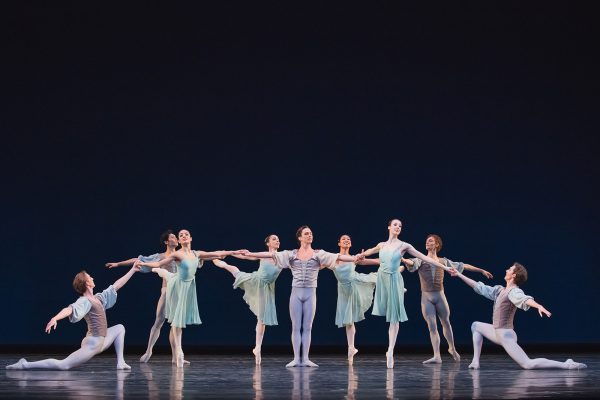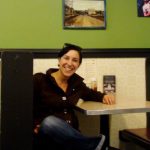On Thursday September 26, Heidi Strauss’s company, adelheid dance productions, performed Elsewhere, co-presented by DanceWorks and NextSteps, at the Harbourfront Centre Theatre. The sold-out crowd — a who’s who of the Toronto dance community — were clearly excited to be attending the world premiere and waited with anticipation for the performance to begin.
Elsewhere, Strauss explains in her program note, is a response to the notion of affect or affect theory. A concept that has been circulating in philosophical spheres since the seventeenth century, affect has become something of a catchphrase within social studies and visual culture in the last twenty-five years. For French radical philosophers Gilles Deleuze and Félix Guattari, affect is the passing or transmission of an experiential state from one body to another. Philosophers discussing or writing about affect articulate a phenomenon that goes largely unacknowledged by living, breathing organisms on a daily basis. Recognizing affect and the act of affecting is one of the concerns of affect theory.
Strauss explains that after an audience member remarked of a previous piece that her work was grounded in affect theory, she decided to work with the concept more attentively. The result of this exploration is the sixty-minute Elsewhere, combining an original sound and image score by Jeremy Mimnagh and set design by Teresa Przybylski. The piece featured dancers Danielle Baskerville, Miriah Brennan, Luke Garwood, Molly Johnson and Brendan Wyatt.
Elsewhere evolves as a series of disconnected scenes with the dancers working almost interchangeably in solos, pairs and in groups. There is no discernible storyline or plot and the dancers do not develop as characters. The piece, instead, presents as a series of free-floating scenes that may have developed around an image or task in the studio, but onstage seem fragmented and unfocused.
At the beginning of the work, Johnson is the first performer to emerge on to the stage from the almost imperceptible breaks in the vertically hung panels that comprise the backdrop. Her steps are hesitant, unfocused. With large, expressive eyes, Johnson looks out into the audience searchingly before her gaze turns inward. Wearing fashionable retro shoes, she begins stamping — slowly at first, then becoming increasingly more outspoken. This is not the rhythmic rapid-fire footwork of a flamenco dancer, instead these are impulsive and irregular steps, like a mad drunk scrambling to kill cockroaches. Eventually Johnson is joined by Wyatt who watches her from a distance before slowly moving toward her. While he is circling, Wyatt smirks at Johnson and his predatory expression contrasts with her obvious unease. I don’t think that Wyatt means Johnson any harm — he may even seek to look out for her — but the scene does not read clearly. After another volley of foot stamping and tripping over herself, Wyatt moves in and lifts Johnson off her feet. Johnson, though, does not react as one might expect. Although she is caught off guard, it is as if Wyatt is a strong gust of wind that changes her direction, shifts her course. He places her back down again and she continues to shuffle and stutter away. Wyatt interrupts her stamping and picks her up again, lifting her a little higher, taking her a little farther. This is repeated several times without Johnson ever acknowledging Wyatt, while he retains that smirking smile. As this duet unfolds, beyond the backdrop, the other dancers move back and forth like punctuating shadows, starting and stopping, turning and hesitating.
The scene ends with Johnson’s flailing movements accelerating to such a degree that she ends up on the floor on stage right. Wyatt comes to her rescue and quickly and easily removes her shoes. (The act is without artifice — something to admire when the removal of costume pieces onstage can prove ridiculously convoluted.) The removal signals the end of the opening scene and the rest of the cast appear.
This first scene sets up a number of questions that follow me throughout my viewing of Elsewhere. Who is Johnson? Is she Strauss? Johnson comes across repeatedly as lost, big eyes looking out into the audience for an answer that eludes her. Wyatt sees Johnson, but Johnson doesn’t see him and this failure to register another’s presence occurs frequently in the work where dancers regard another member but the subject does not see them. Also, there are a number of sections where Wyatt and Garwood, the other male member of the cast, stare each other down. Are they rivals? Are they both competing for Johnson’s affection? But what affection, since Johnson is adrift and disconnected from the group? There are all these moments when the cast stop and stare at each other as though apropos of something — like walking through the woods and hearing a noise, stopping and holding one’s breath to discern where the noise came from and what its intentions might be. But why? What noise or disturbance are they registering? Why do they keep stopping and looking? Why was Wyatt smirking? All through my notes, scrawled as I watched the piece, was the word “why?”
To be clear, I am not a dance- or theatre-goer who needs a story. I believe that as viewers we look for patterns of movement — patterns, coincidentally, of affect. But there was something dramaturgically about Elsewhere that kept posing questions that were never answered. If this was Strauss’s intention then I suppose it was successful. Unfortunately, after so many red herrings and cold trails, of watching closely and learning nothing, I sat back and my “whys” were replaced with “so whats?”
At three junctures in the work, dancers address the audience — twice Johnson and once Garwood. With their lovely voices, each addressed the audience clearly and with commitment. However, the content of these truncated monologues, descriptions of what “it felt like,” were so inconsequential as to have me sitting back in my seat at the end saying “and?” Each time, the speaker stumbled intentionally over the right words needed to say something that was unsayable, to make meaning out of meaninglessness. Again, this was likely the point. But isn’t art-making a process of defining the undefinable and giving meaning where meaning is lacking? Strauss repeatedly draws attention to the absence of certainty, yet this did not seem like enough in and of itself to create the desired effect. Is it braver not to offer answers? Maybe. I don’t know, but I think words need to be chosen carefully and implied meaning crafted into the text.
In another scene later in the piece, Garwood tries to leave the stage but his every motion and change of direction elicits an immediate response from the other dancers. They follow him, track his progress, responding to his ebb and flow. The difference in this scene is that Garwood is aware of the effect his movements and intention are having on those around him. He tries to shake them off and the sense of tension that his recognition of cause and effect creates stands out for its clarity.
Within all of this, Baskerville emerges as a beacon of light. Each time she is onstage her interpretation of Strauss’s choreographic vocabulary gives the movements weight and focus. She creates poetry from the ordinary movements she has been given and sculpts them. Her movements possess the attunement of a method actor imbuing each sequence with intention and gravity — movements that otherwise just pass through the other dancers.
Leaving all this aside, the crowning achievement of Elsewhere is the synergy created between the set, the music and the lighting. In email correspondence after opening night, Strauss explains that the set, in particular, was a collaborative endeavor. Strauss along with lighting designer Rebecca Picherack, projection designer Mimnagh and set designer Przybylski went through a number of design iterations in order to find exactly what they were looking for, and I am glad they went to the trouble. The interaction of the dancers, the images and the lighting with the set makes the piece. The set is a series of acetate panels, vertically hung and five feet across. Each was hand-painted and etched on one side so that one surface would accommodate clear projections while the other would reflect light. The panels’ responsiveness was used to advantage throughout Elsewhere by the combination of Picherack’s lighting and Mimnagh’s projections. The images were indistinct, often dark, oily and blurred but still poignant and evocative in their Rorschach-ness. “We wanted a space that could change so time registered in a different way [and which gave] the possibility of projection and reflected light. We also had to be able to fit the show into the back of our Honda Civic!” explains Strauss.
Although, as I found out from Strauss, she and the dancers worked in silence for the final phase of the development of Elsewhere, the addition of Mimnagh’s score did not seem incongruous. Influenced by electronic artists like Coil and Throbbing Gristle, Mimnagh did not use samples but relied on the digital manipulation of everyday sounds. “The sound was processed,” explains Strauss. “Sometimes it’s as simple as a recording of the dancers’ … feet on the floor, or a cello or wind [or other] natural sound transposed or pitch-shifted to sharpen the perspective.” There were moments when the sound cued nostalgia — tinkling bells or wind chimes coming from a distance — or fear in the way sound is sucked from a room.
The combination of the sound, the moving images and the lighting effects created a very complete and unique look and feel for the piece. The result was the suspension and elongation of time with the dancers moving on and off stage through a dreamlike world that was tinged with memory, remorse and longing. For my part, I wished that each scene had a more defined sense of purpose that contributed to some kind of global statement or idea within the work. The tempo and tone remained unchanged and the lack of clarity — all the questions — confounded me. In the end, despite the very strong production values, Elsewhere felt like a riddle that lost my interest before it could be solved.
Tagged: Choreography, Contemporary, ON , Toronto





